“Give me a break!” – Options for paddocks infested with both root lesion nematodes and Rhizoctonia solani AG8
“Give me a break!” – Options for paddocks infested with both root lesion nematodes and Rhizoctonia solani AG8
Author: Bec Swift, Sarah Collins, Carla Wilkinson, Daniel Hüberli, Carla Milazzo, Alice Butler, Sean Kelly, Garren Knell | Date: 13 Feb 2020
Key messages
- To reduce the risk of yield loss it is imperative to understand which soilborne pests and diseases are present before making crop rotation decisions.
- Weed-free fallow, pulses and pastures can be the best options where root lesion nematodes (RLN) and Rhizoctonia solani AG8 co-exist in a paddock.
- Canola is not an effective break crop for RLN.
- Cereals can substantially increase RLN and R. solani levels within one cropping season.
Aims
Two-year rotation trials were implemented at Calingiri, Dumbleyung and Grass Valley to investigate the most effective and profitable break crops in rotation with cereals (wheat) for growers with RLN and R. solani in the same paddock.
Introduction
Rhizoctonia solani AG8 (Rhizoctonia bare patch) is a fungal pathogen that causes root rot in several Western Australian crops and can cause significant yield losses; up to 50% in wheat (Table 1). Root lesion nematodes (RLN) can also cause significant crop yield losses; up to 40% in wheat (Table 1). For RLN alone, this equates to losses in WA of up to AU$90M annually in wheat crops (Brennan et al 2018; Murray et al 2009). In WA, Rhizoctonia bare patch and RLN often occur together in the same paddock, making management more complicated. Therefore, it is imperative for grain growers in WA to have suitable crop rotations for these soilborne diseases.
This paper presents the findings from the first-year break crop phase at Calingiri (2019) and the second-year cereal phase (2019) at Dumbleyung and Grass Valley which followed 2018 break crops. Results of the first-year break crop rotation at Dumbleyung and Grass Valley are presented in the 2019 Research Updates paper (Swift et al 2019).
Table 1. Western region wheat yield loss risk categories for root lesion nematodes (RLN);Pratylenchus neglectus and P. quasitereoides,and Rhizoctonia solani AG8(McKay et al 2018).

Method
Three break-crop trials were established in paddocks on grower properties at Calingiri, Grass Valley and Dumbleyung, where RLN and R. solani were both present at levels impacting yield. The break-crop phase was sown in 2018 at Dumbleyung and Grass Valley and the cereal phase was sown in 2019. At Calingiri the break-crop phase was sown in 2019.
The crop rotation trials were implemented using break crop options agronomically suitable for the Calingiri, Grass Valley and Dumbleyung regions (Table 2). The trial in Dumbleyung was a randomised block design with four replicates. In Grass Valley and Calingiri, there were six replicates for each treatment and for weed control purposes, treatments were grouped into blocks of broad leaf or cereals with a fallow plot (repeated herbicide applications) included in each block. Nitrogen fertilisers were only applied to the cereals and the canola. In 2019, the Dumbleyung and Grass Valley trial sites were over-sown with wheat varieties known to be susceptible to RLN (Chief CL at Grass Valley and Scepter at Dumbleyung). Total nitrogen applied to wheat at Grass Valley was 95 kgN/ha and at Dumbleyung, 65 kgN/ha.
Table 2. Break-crop treatments (crop type and variety) sown at each site in 2018 and 2019.
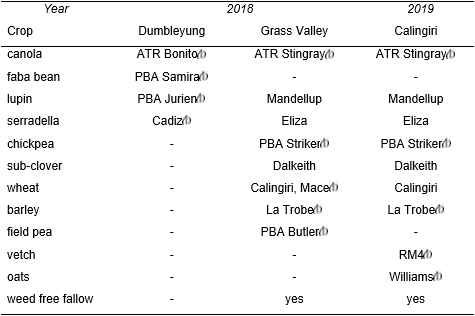
Pre-season sampling to obtain the baseline soilborne pathogen and nematode pest levels at each site included soil nutrient analyses and testing for R. solani and RLN levels using qPCR (Pinitial) in each plot. R. solani and RLN levels using qPCR were also measured from each plot after harvest (Pfinal).
ANOVA (Genstat 19th Edition) was performed on the square root or cube root transformed data (where necessary) for Pi and Pf qPCR results, pre-season nitrogen levels and grain yields. Multiple comparisons (p<0.10) were performed using Fisher’s Protected LSD. Simple linear regression analyses between RLN or R. solani and yield were performed on square root or cube root transformed data.
Results
2019 pre-season nitrogen at Grass Valley and Dumbleyung
At Grass Valley, all levels of ammonium N at the start of the 2019 season were similar regardless of the crop sown in 2018 (p>0.10) (Table 3). However, the nitrate N levels were significantly (p<0.10) higher in the 2018 fallow treatments compared with all but the canola treatment. At Dumbleyung, statistical analyses on the ammonium N results were not done as some of the results were below detection levels (Table 4). The nitrate N levels were significantly (p<0.01) higher in the faba bean and serradella plots compared with the canola and lupin plots.
Table 3: Pre-season nitrogen levels at Grass Valley in 2019 following a range of break crops grown in 2018.
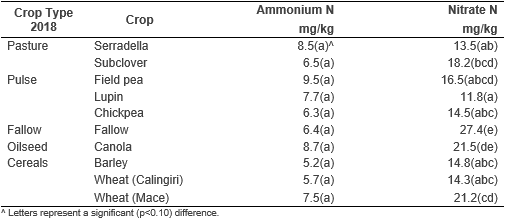
Table 4: Pre-season nitrogen levels at Dumbleyung in 2019.
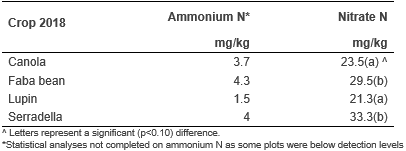
Grain yields
At Grass Valley in 2019, the highest wheat yields were from plots that sown to serradella or kept fallow in 2018 (Figure 1). These yields were 79% and 98% higher respectively than the 2018 barley plots. Wheat grain yields in 2019 were significantly higher in all of the legume treatments than the cereal treatments and yield on the canola treatment was higher than on the 2018 barley and Calingiri wheat treatments.
Regression analyses demonstrated that low levels of P. quasitereoides (p=0.02) or high nitrate levels (p=0.001) at the start of the season were correlated with the higher yields. However, the levels of P. neglectus and R. solani at the beginning of the season did not correlate with grain yields.
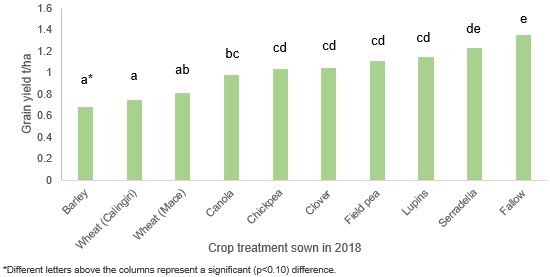
Figure 1. 2019 grain yields of wheat (Chief CL) sown over the 2018 break-crop rotation trial at Grass Valley.
At Dumbleyung, the 2019 wheat yields on the 2018 serradella treatment were significantly lower by more than 1t/ha compared to the other three treatments (Figure 2) due to herbicide carryover from 2018 when serradella plots were sprayed with Spinnaker® herbicide and only 282mm rain was received between 1 May 2018 and 1 May 2019. This did not meet the requirement for Spinnaker® of 400mm rainfall before planting to cereals. There was no significant difference in yield in the treatments sown to canola and the pulses in 2018.

Figure 2: 2019 grain yields of wheat (Scepter) sown over the 2018 break-crop trial at Dumbleyung.
At Calingiri, yields were low for all crops in 2019 (Figure 3) reflecting the disappointing yields throughout most of the State (GIWA, 2019; Loi et al 2005). Vetch and sub-clover were not harvested for grain yield. Canola and chickpea yields were particularly poor which could have been due to the late sowing (June) of the trial or the impacts of RLN infestation.
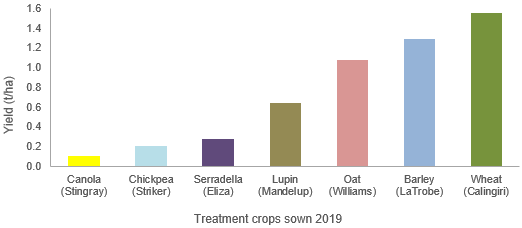
Figure 3. 2019 break-crop yields at Calingiri.
RLN and R. solani qPCR analyses in 2019
Visual symptoms of RLN and Rhizoctonia in plots were obvious in cereals at all three sites during the 2019 season. Symptoms included chlorotic plants, stunting and patching.
Grass Valley
At the start of the growing season in 2019, the root lesion nematode numbers were lowest in the plots sown to lupin and field pea or fallow in 2018 (Table 5). At harvest, the lowest amount of P. quasitereoides was in the plots sown to serradella, subclover and lupin in 2018 and the highest amount was in the 2018 canola plots. At the end of the season, there was no significant difference in the final numbers of P. neglectus.
There was no significant difference in the levels of R. solani between any of the 2018 treatments at the start of the season in 2019 (Table 5). However, at harvest, levels of R. solani were significantly lower in the 2018 lupin plots compared with the 2018 chickpea, canola, fallow and cereal plots. Serradella plots had variable levels of R. solani at the end of season (Table 5).
Table 5. 2019 Pratylenchus neglectus (RLN/g soil), P. quasitereoides (RLN/g soil) and Rhizoctonia solani AG8 (log pgDNA/g soil) levels at the start of the season (Pi) and at harvest of wheat crop grown (Pf) at Grass Valley.
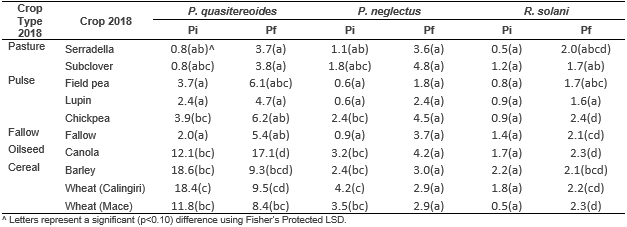
Dumbleyung
P. neglectus levels at sowing and harvest in 2019 were at least three times higher in the 2018 canola plots at Dumbleyung than the faba bean and lupin plots. Serradella had higher P. neglectus levels at the end of the season than faba beans and lupins but levels were not as high as those in canola (Table 6). There were no differences in R. solani levels between the four treatments in the 2019 growing season.
Table 6. Pratylenchus neglectus (RLN/g soil) and Rhizoctonia solani AG8 (log pgDNA/g soil) levels from the start of the season (Pi) and at harvest (Pf) of wheat grown at 2019 at Dumbleyung.

Calingiri
P. quasitereoides (av. 37 RLN/g soil), P. neglectus(av. 1.7 RLN/g soil) and R. solani (av. 1.7 log pgDNA/g) levels at sowing were at high (RLN’s combined) and medium (R. solani) risk of yield loss for wheat (Table 1). RLN and R. solani levels were also consistent across the treatment plots before sowing (p>0.10).
At harvest, P. quasitereoides levels were significantly (p<0.10) lower in the chickpea, pasture legumes and fallow plots (Table 7). P. neglectus was present at the site at much lower levels than P. quasitereoides and levels did not change significantly over the season (p>0.10). R. solani levels were not significantly (p>0.10) different at sowing, but at harvest the levels were significantly (p<0.10) higher in the cereals than the other treatments. Lupin and subclover had the lowest levels of R. solani at the end of season.
Table 7. Pratylenchus neglectus (RLN/g soil), P. quasitereoides (RLN/g soil) and Rhizoctonia solani AG8 (log pgDNA/g soil) levels at harvest (Pf) at Calingiri in 2019.
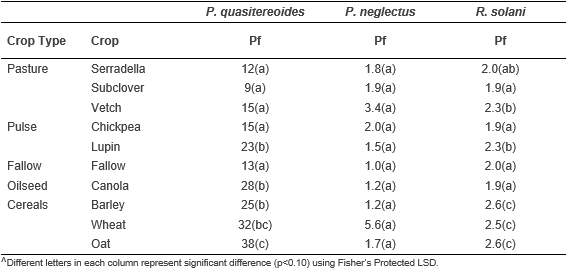
Conclusion
In general, RLN levels were lower under fallow, pulses and pastures and higher under cereals and canola. After the Grass Valley site was over-sown with wheat in 2019, the 2018 pasture, pulse and fallow treatments all yielded more than the 2018 cereal treatments and the higher grain yields were correlated (simple linear regression) with low levels of P. quasitereoides at the start of the season. The highest levels of P. quasitereoides and P. neglectus at harvest in 2019 wheat plots were recorded from 2018 canola treatments at Grass Valley and Dumbleyung, respectively.
R. solani AG8 levels were lowest under subclover pasture, both in the initial break-crop phase and in the cereal phase at the Calingiri and Grass valley sites, respectively. Field pea and lupin treatments grown in 2018 also produced lower levels of R. solani AG8 at harvest in the 2019 cereal phase at Grass Valley. In Calingiri, the lowest levels of R. solani AG8 at harvest were in some of the pasture, pulse, canola and fallow plots when compared with the cereal plots.
In general, subclover and lupin rotations were the most consistent break-crop options where R. solani and RLN were present in the same paddock (Grass Valley and Calingiri trials). Serradella consistently performed as a suitable break to reduce P. quasitereoides but its ability to reduce P. neglectus and R. solani levels was more variable. Fallow, pulses and pasture rotations generated the highest yields in subsequent wheat crops. Canola is not a suitable break where RLN and R. solani occur together. In 2020, wheat will be sown over the trial at Calingiri to further validate these findings.
These results demonstrate that growers need to be aware of which nematode pests and soil-borne diseases are present in problem paddocks so that suitable rotations can be implemented to mitigate potential yield losses.
References
Brennan JP et al., (2018) Economic impact of root lesion nematodes and crown rot on wheat production in Australia. DEDJTR report (submitted). Melbourne, Australia.
GIWA (2019) Crop Report – 13 December 2019, Grains Industry Association of Western Australia. http://www.giwa.org.au/2019
Loi, A., et al., (2005) A second generation of annual pasture legumes and their potential for inclusion in Mediterranean-type farming systems. Australian Journal of Experimental Agriculture 45, 289-299.
McKay A et al. (2018) Broadacre Soilborne Disease Manual Version 10.1. The South Australian Research and Development Institute (SARDI) http://www.rootdisease.aweb.net.au
Swift B et al. (2019) Profitable break crops for management of root lesion nematodes and Rhizoctonia solani AG8. 2019 GRDC Research Updates, Crown Perth, February 25-26. https://researchrepository.murdoch.edu.au/id/eprint/52748/
Murray GM et al. (2009) The current and potential costs of diseases of wheat in Australia. Australian Journal of Plant Pathology, 38, 558-570. ISBN 978-1-875477-92-0
Acknowledgments
Funding for this work was provided by DPIRD and GRDC. Our thanks to Grace Williams from Kalyx and the DPIRD Northam and Katanning RSU’s, particularly Rob de Gruchy, Daron Malinowski and Daniel Cox for trial management. Andrew van Burgel assisted with the trial design. Kanch Wickramarachchi, Pete Gray, Isaac Duval and a team of casuals provided technical support. The growers Brendan Parker (Grass Valley) and Glenn Ball (Dumbleyung) and Steve woods (Calingiri) provided their paddocks for the trials and we would like to thank them for their cooperation and continued support.
Contact details
Dr Sarah Collins
Department of Primary Industries and Regional Development
Western Australia, 3 Baron Hay Court, Kensington
(08) 9368 3612
sarah.collins@dpird.wa.gov.au
GRDC Project Code: DAW00256,
